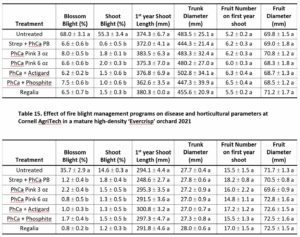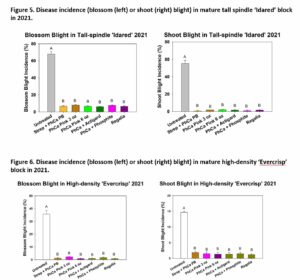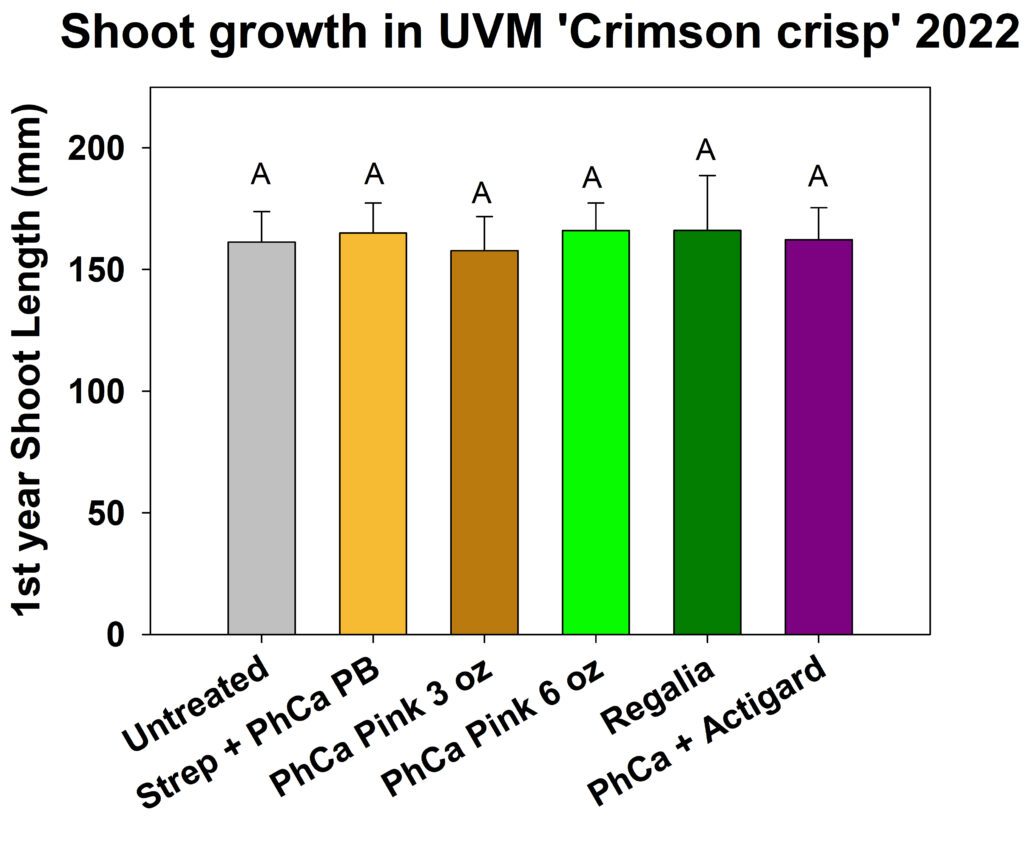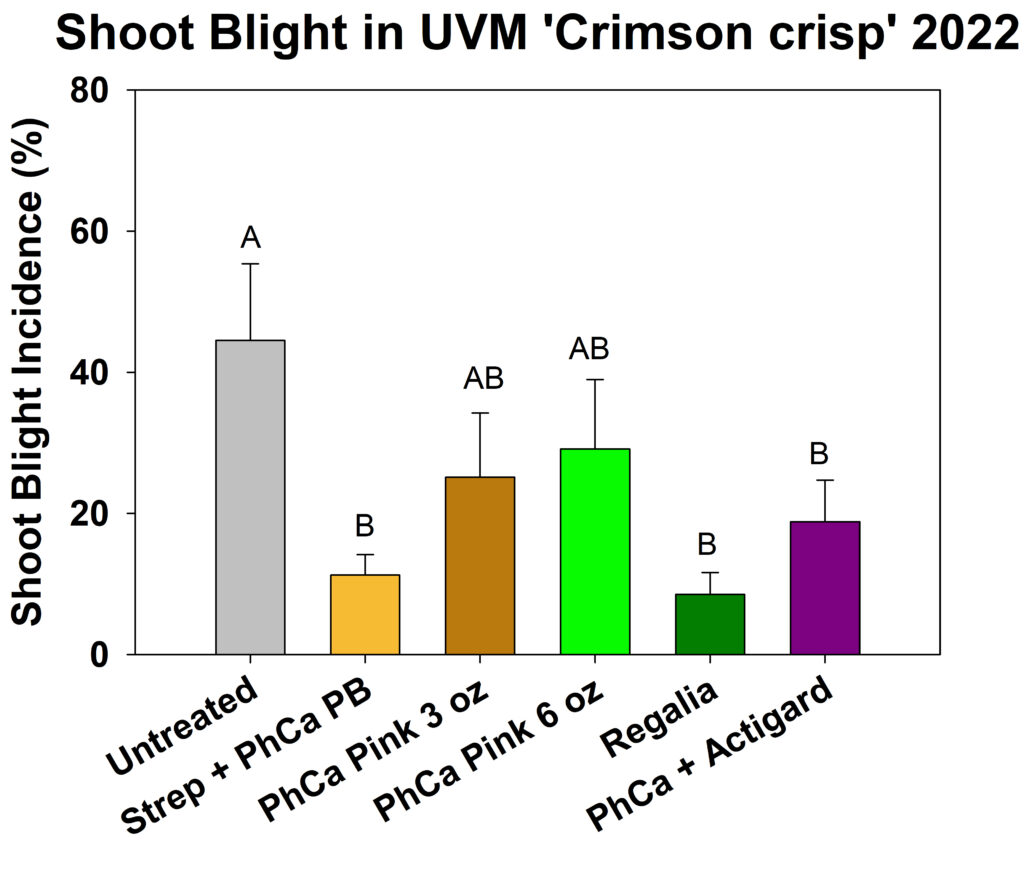Final report for LNE19-385R
Project Information
Fire blight, a bacterial disease of rosaceous plants caused by Erwinia amylovora, is one of the most important diseases affecting commercial apple production worldwide. Antibiotics, applied at bloom to protect against blossom infection, are the most effective means of management, but raise concern due to the potential for antibiotic resistance in both the pathogen population and non-target organisms. In addition, most fire blight outbreaks in New York State often emerge in late June to July as shoot blight, calling into question the role of blossom infections and the antibiotic applications made to manage them. Prohexadione-calcium (PhCa) is a gibberellic acid inhibitor used post-bloom to control shoot vigor and to manage shoot blight. However, the magnitude of shoot blight management is directly related to the suppression of shoot growth, which is undesirable, especially in young orchards during establishment years. PhCa is believed to control shoot blight by thickening cell walls in cortical parenchyma, preventing invasion of host tissues by E. amylovora. We hypothesize that PhCa applied pre-bloom could similarly prevent invasion of blossom pedicels following infection leading to reduced disease incidence. We evaluated novel pre-bloom PhCa programs for their effects on disease management (blossom and shoot blight) as well as their impact on shoot growth for four years in a orchard of ‘Gala’, ‘Idared’, ‘Evercrisp’, CrimsonCrisp’, and ‘Topaz’ in Vermont and New York. After extensive experimentation at two locations and four cultivars over four seasons, we found when the PGR Prohexadione Ca applied was earlier in the season at the pink stage it has the potentially reduce blossom blight and serve as a replacement for the antibiotic streptomycin with little to no detrimental horticultural impacts. Additionally, through these years of experimentation, we have learned that the vigor of the planting can greatly influence this practice. In particular, low vigor blocks or blocks transitioning to organic may be so physiologically inactive that they may not respond to the Prohexadione Ca treatments. In this case, biopesticides or other defense inducers may be a better option for blossom blight control. Fortunately, low-vigor blocks rarely develop shoot blight under natural conditions. The use of Prohexadione Ca at pink a good option for the management of fire blight in young vigorous blocks in the establishment year. This would especially be the case for varieties like ‘Honeycrisp’ which is less susceptible and where pink applications of Prohexadione Ca also have the potential to reduce bitter pit.
The objective of this work is to optimize use of the plant growth regulator, prohexadione calcium, natural plant defense activators, and biological antimicrobials to manage the bacterial disease fire blight (Erwinia amylovora) expressing both as blossom and shoot blight, without the use of antibiotics or compromising tree productivity. To achieve transition to practice, trials demonstrating both disease management and unhindered tree performance will be needed for regionally important cultivars.
Fire blight, a bacterial disease of rosaceous plants caused by Erwinia amylovora, is one of the most important diseases affecting commercial apple production worldwide. Antibiotics, applied at bloom to protect against blossom infection, are the most effective means of management, but raise concern due to the potential for antibiotic resistance in both the pathogen population and non-target organisms. In addition, most fire blight outbreaks in New York State often emerge in late June to July as shoot blight, calling into question the role of blossom infections and the antibiotic applications made to manage them. Prohexadione-calcium (PhCa) is a gibberellic acid inhibitor used post-bloom to control shoot vigor and to manage shoot blight. However, the magnitude of shoot blight management is directly related to the suppression of shoot growth, which is undesirable, especially in young orchards during establishment years. PhCa is believed to control shoot blight by thickening cell walls in cortical parenchyma, preventing invasion of host tissues by E. amylovora. We hypothesize that PhCa applied pre-bloom could similarly prevent invasion of blossom pedicels following infection leading to reduced disease incidence. We evaluated novel pre-bloom PhCa programs for their effects on disease management (blossom and shoot blight) as well as their impact on shoot growth for four years in a orchard of ‘Gala’, ‘Idared’, ‘Evercrisp’, CrimsonCrisp’, and ‘Topaz’ in Vermont and New York.
Cooperators
- (Educator and Researcher)
- (Researcher)
Research
We hypothesize that the novel fire blight management programs tested here, including prohexadione calcium, plant defense activators, and biological products, can provide sustainable fire blight control for commercial productions, without negative impact to tree productivity or performance. Specifically, we predict that prohexadione calcium applied pre-bloom at low doses can control blossom and shoot blight, without reducing tree vigor. Biological materials may provide additional protection by outcompeting the pathogen at the point of primary infection. Plant defense activators prime host defenses, making them less susceptible to infection. These programs would offer an alternative to the currently accepted form of control, antibiotics.
In the first two years of this project, we evaluated several management programs for the management of fire blight using the plant growth regulator prohexadione-calcium (PhCa), trade name Apogee (BASF), plant defense activators, and other biopesticides.
Research Sites
Field trials were conducted at two research sites in the Northeast, with a mature semi-dwarf block and a young high-density block in each location (for a total of four orchard blocks):
- Cornell AgriTech Research Orchards
- A mature planting of ‘Gala’ apples on B.9 rootstock, established 2000 (year 1)
Or a mature planting of ‘Empire’ apples on B.9 rootstock, established 2000 (year 2) - A young planting of ‘NY-1’ apples on G.935 rootstock, established 2017
- University of Vermont Horticultural Research Farm
- A mature planting of ‘Crimson Crisp’ and ‘Topaz’ apples, established 2017
- A young planting of ‘Macoun’ apples on G.41, rootstock established 2017
Methods
In each orchard, a randomized complete block design was established with four replications; an experimental unit consisted of a single tree in mature blocks or panel of several trees in young blocks. Materials and experimental treatments are summarized in Tables 1-3 below. Treatments were slightly modified from those initially proposed; changes were made based on discussions with advisory board, the opportunity to inoculate fields, and limitations of tree number and ability to visit remote field site regularly. In addition, orchard blocks received slightly different treatments, as noted in the treatment table, due to limited number of trees at some sites. At most sites, treatments were applied to the same trees in subsequent years in order to evaluate the cumulative effects on horticultural characteristics. In the mature orchard trial at Cornell AgriTech, a different block of trees was used in the second year in order to evaluate the effects of treatments on disease control for different cultivars.
PhCa has been recommended for shoot blight management since it was registered for use as a plant growth regulator for tree fruit in 1999. However, disease control is correlated with reduction in shoot growth. In trials conducted at Cornell AgriTech from 2016-2018 in a bearing semi-dwarf block, we have seen promising results using PhCa at lower rates applied pre-bloom for management of blossom and shoot blight, without shoot growth reduction. Therefore, we and the advisory board were most interested in evaluating the most promising programs in multiple site and in plantings of different ages. Specifically, PhCa was used alone pre-bloom (at pink or tight cluster, ~1 or 2 weeks pre-bloom, respectively) at two different rates (3 and 6oz/100gal), reflecting lower rates than would be used for shoot growth reduction or post-bloom fire blight control. We also evaluated in combination with another products. These combinations included Actigard (acibenzolar-methyl) or Rampart (a phosphite fungicide), both of which act by inducing plant defenses and have been effective in other fire blight trials. In addition, we evaluated Regalia, a plant defense inducer whose active ingredient is a plant extract produced from Reynoutria sachalinensis. This material has also has been a top performer in our research trials at Cornell AgriTech over the past few years.
Table 1. Trade Names of Commercial Products used in Trials
|
Trade Name (Company) |
Active ingredient |
Type |
|
Apogee |
Prohexadione calcium |
Plant growth regulator |
|
Regalia CG |
Reynoutria extract |
Plant defense activator |
|
Actigard |
Acibenzolar-S-methyl |
Plant defense activator |
|
Rampart |
Phosphite fungicide |
Plant defense activator |
|
Magna Bon CS 2005 |
Copper sulfate pentahydrate |
Adjuvant applied with Regalia |
Table 2. Experimental Fire Blight Management Programs – Mature Orchards
|
Abbreviation |
Treatment |
Rationale |
|
Untreated |
Untreated |
Control |
|
Strep* |
FireWall17 24oz @ bloom |
Grower standard |
|
Strep + PhCa PB |
FireWall17 24oz @ bloom, |
Grower standard, negative control for reduced shoot growth |
|
PhCa TC 3oz** |
Apogee 3oz/100gal @ tight cluster |
PGR low rate, ~2 weeks pre-bloom |
|
PhCa TC 6oz** |
Apogee 6oz/100gal @ tight cluster |
PGR high rate, ~2 weeks pre-bloom |
|
PhCa Pink 3oz |
Apogee 3oz/100gal @ pink |
PGR low rate, ~1 week pre-bloom |
|
PhCa Pink 6oz |
Apogee 6oz/100gal @ pink |
PGR high rate, ~1 week pre-bloom |
|
Regalia |
Regalia 32floz |
Plant defense activator |
|
PhCa + Actigard* |
Actigard 1oz/100gal |
Plant defense activator |
|
PhCa + Phosphite* |
Rampart 64floz/100gal |
Plant defense activator |
Table 3. Experimental Fire Blight Management Programs – Young Orchards
|
Abbreviation |
Treatment |
Rationale |
|
Untreated |
Untreated |
Control |
|
Strep + PhCa PB* |
FireWall17 24oz @ bloom, |
Grower standard, negative control for reduced shoot growth |
|
PhCa 3oz |
Apogee 3oz/100gal @ pink |
PGR low rate |
|
PhCa 6oz |
Apogee 6oz/100gal @ pink |
PGR high rate |
|
PhCa 3oz + SO** |
Apogee 3oz/100gal @ pink |
PGR low rate |
|
PhCa 6oz + SO** |
Apogee 6oz/100gal @ pink |
PGR high rate |
|
Regalia |
Regalia 32floz |
Plant defense activator |
|
PhCa + Actigard* |
Actigard 1oz/100gal |
Plant defense activator |
|
PhCa + Phosphite* |
Rampart 64floz/100gal |
Plant defense activator |
|
PhCa Trickle** |
Apogee 2oz/100gal @ pink, petal fall, and two weeks later |
PGR ‘trickle’ program for duration of season |
*Only included at University of Vermont
**Only included at Cornell AgriTech
To ensure adequate disease pressure under the most intense conditions, bearing blocks were inoculated at 80 to 90% bloom (May) with Erwinia amylovora strain Ea 273 at 1×106 CFU ml-1 using a hand-pumped Solo backpack sprayer. Young blocks were not inoculated, so that treatments could be evaluated for effects on horticultural characteristics with low or absence of disease pressure. Applications were made using at the full field rates for apples according to label recommendations at the appropriate timings, using a SOLO 451 Backpack Mist Blower calibrated to output at 100 gal/A.
Data Collection
Disease management. To measure efficacy of programs for controlling fire blight (in mature orchard blocks only), blossom and shoot blight symptoms were assessed on blossom clusters and terminal shoots in July once symptoms were reliably detectable. For each of 4-6 replicate trees per treatment, 20 collections of five blossom clusters (number of blighted blossoms per cluster) and the percentage of blighted first year shoots were assessed.
Horticultural Impact. To assess potentially negative impacts on trees and crop, horticultural characteristics were measured. Shoot length, fruit number, fruit size, and fruit set per trunk cross sectional area (TCSA) were evaluated at two points in the season: once in mid-July at approximately terminal budset, the point at which trees stop putting on significant vegetative growth, and once mid-September at harvest when growth is concluded for the season. For each of 4-6 replicate trees per treatment, percent incidence of blossom and shoot blight was assessed for 20 blossom clusters (number of blossoms blighted of 5) or 20 first year shoots.
Disease incidence and host response data were subjected to analysis of variance (ANOVA) for a randomized block design using accepted statistical procedures and software (i.e. Generalized Linear Mixed Models (GLIMMIX)) procedure of SAS (version 9.4; SAS Institute Inc., Cary, NC). All percentage data were subjected to arcsine square root transformation prior to analysis. In Year 2, data were analyzed with a linear mixed effects model using the ‘lmer’ command in lme4 package of R with treatment as main effect and replication as random effect (Bates et al. 2015). Analyses were carried out in R version 3.6.3 (R Core Team 2020).
Year 1
Disease Management. At Cornell AgriTech, in the mature semi-dwarf block, the untreated trees experienced 88.1 ± 3.3 and 54.7 ± 5.4 % incidence of blossom and shoot blight respectively. All treatments experienced significantly less blossom and shoot blight (p < 0.0001, Table 4, Figure 1). Antibiotic programs performed the best with a mean of less than 5.7 ± 3.7 or 1.0 ± 1.0 % blossom and shoot blight respectively. The experimental treatments frequently provided similar (non-significantly different) levels of disease control as compared to antibiotic programs. Pre-bloom PhCa applications at both rates and timings experienced less than 20% or 10% blossom or shoot blight incidence respectively.
At University of Vermont in the mature orchards, treatments frequently had a significant effect on blossom blight incidence, although effects were not as great as at the Cornell AgriTech orchard (Figure 2, Table 4). The untreated trees experienced 64.0 ± 15.4 and 18.0 ± 10.0 (‘Crimson Crisp’) or 69.0 ± 10.0 and 13.3 ± 7.8 (‘Topaz’) percent incidence of blossom and shoot blight respectively. For ‘Crimson Crisp,’ only antibiotic programs experienced significantly less blossom blight than untreated trees, with a mean of 10.9 ± 5.2 % (p < 0.0001, Figure 2). For Topaz, all experimental programs had less blossom blight than the untreated trees (p < 0.0001, Figure 2). Antibiotics performed the best (19.2 ± 9.7 %), followed by Regalia (26.2 ± 5.6 %), and then by the pink PhCa programs, ranging from 39.5 to 44.5 % incidence. Shoot blight pressure was not adequate for either cultivar to draw conclusions about experimental treatments.
Horticultural Impact. At Cornell AgriTech in the mature semi-dwarf block, minimal differences were observed between treatments with regard to horticultural parameters (Table 4). There was a significant effect on shoot length at harvest (p < 0.0001, Figure 3). Post-bloom applications of PhCa reduced shoot length, as expected; tight cluster application of PhCa at the higher rate also reduced shoot length as compared to the untreated trees. Trunk size (p = 0.2851) and fruit size (p = 0.0730) were not impacted by treatments. Fruit number was influenced by treatment (p = 0.0096), with the tight cluster application of PhCa at the higher rate having the higher fruit number than the streptomycin application at bloom; however, neither were different than untreated trees.
At University of Vermont in the mature semi-dwarf block, similarly, experimental treatments had a minimal impact on horticultural parameters (Tables 5 and 6). Shoot length at harvest was impacted for both ‘Crimson Crisp’ (p = 0.0023) and ‘Topaz’ (p = 0.0019). For ‘Crimson Crisp,’ the lower rate of PhCa at pink and the PhCa+Actigard treatments had shorter shoots than the untreated trees. For ‘Topaz’ the lower rate of PhCa at pink had longer shoots than the Regalia treatment, but neither were different than the untreated control. More importantly, shoot growth in this block (both varieties) was minimal due to low vigor (<20 cm of growth), and this data is likely not an accurate representation of whether that shoot length was compromised by treatments.
At Cornell AgriTech in the young high-density planting, experimental treatments did not have an effect on any of the horticultural parameters (Table 7) evaluated including shoot length (p = 0.4071), trunk diameter (p = 0.2337), fruit number (p = 0.1207), and fruit size (p = 0.4217).
At University of Vermont in the young high-density planting, experimental treatments also did not have an effect on any of the horticultural parameters evaluated (Table 8), including shoot length (p = 0.3387), trunk diameter (p = 0.8405), fruit number (p = 0.1596), and fruit size (p = 0.5535).
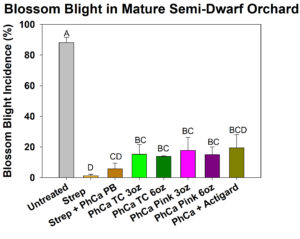
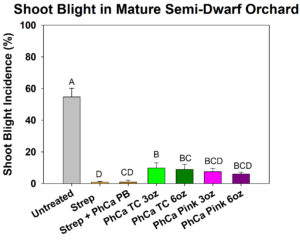
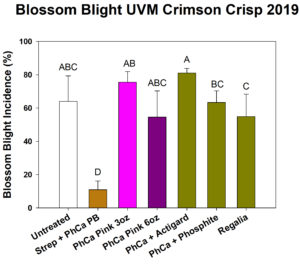

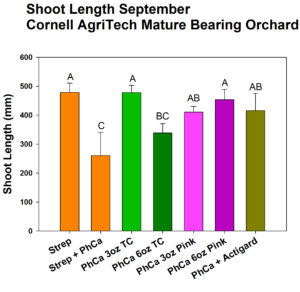


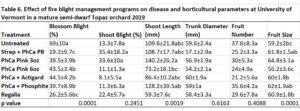
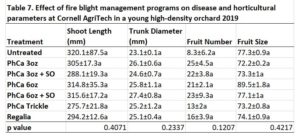

Year 2
In year two, we observed very similar results compared to the first year’s evaluation.
Disease incidence. In the mature orchard at Cornell AgriTech, disease incidence in untreated control trees was 82.0 ± 6.4 and 42.6 ± 5.9 % incidence for blossom and shoot blight, respectively, indicating disease incidence was sufficient for reliable evaluation of treatments. Both blossom and shoot blight were significantly affected by treatments (Table 9). Blossom and shoot blight were both significantly lower for all treatments than Untreated trees (p < 0.0001). No difference was detected between other treatments. Disease incidence was always less than 30% and 13% for blossom and shoot blight respectively. In addition, no differences were detected between treatments for any of the horticultural parameters evaluated.
In the mature ‘Crimson Crisp’ and ‘Topaz’ orchards at University of Vermont, blossom blight incidence in the Untreated treatment was 84.4 ± 3.4 % and 60 ± 7.5 %, respectively, again indicating sufficient disease pressure for evaluation of treatments. In both orchards, disease incidence was significantly effected by treatment (Tables 10 and 11). Strep+PhCaPB was the most effective at reducing blossom blight in both orchards with 52.5 ±8.4 and 9.5 ± 4.0 % incidence, in respective orchards. In the ‘Crimson Crisp’ orchard, only Strep+PhCaPB and PhCa+Actigard significantly reduced blossom blight compared to the Untreated treatment (p < 0.0001). In the ‘Topaz’ orchard, all the experimental fire blight programs successfully reduced blossom blight incidence (p = 0.0006). Shoot blight incidence was again very low in the Untreated treatment with 21.0 ± 4.3 % and 1.4 ± 1.1 % incidence in the ‘Crimson Crisp’ and ‘Topaz’ orchards, respectively. None of the experimental treatments resulted in significantly different shoot blight control than the Untreated trees (p = 0.2291 and 0.7334).
Horticultural Impact. In the mature ‘Empire’ orchard at Cornell AgriTech as well as the mature ‘Crimson Crisp’ and ‘Topaz’ orchards at University of Vermont, no significant effects were detected for any of the horticultural parameters that were evaluated (Tables 9-11, p > 0.05).
In the young, high-density plantings, minimal impact was observed on horticultural parameters at both Cornell AgriTech (Table 12) and at the University of Vermont (Table 13). In the ‘NY-1’ orchard at Cornell Agritech, shoot length was impacted in both July (p = 0.027) and September (p = 0.0012) measurements. In both cases, the PhCa Trickle program significantly reduced shoot length as compared to Regalia and PhCa 6oz in July and the Untreated trees at harvest. In the ‘Macoun’ orchard at University of Vermont, horticultural parameters were never impacted by treatments (p > 0.05).

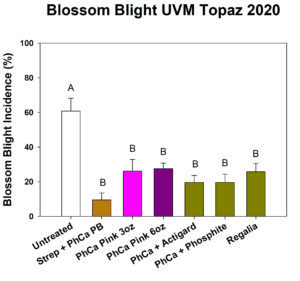





Year 3.
In year three, the pandemic travel restrictions in early 2021 forced us to conduct both trials at Cornell AgriTech as opposed to a third year at UVM. With the NCE, we plan to conduct a third year at UVM this spring pending travel restrictions if any.
Disease incidence.
Across both sites, the weather was cool and not conducive for the development of fire blight until the end of petal fall and the weeks following. In the tall spindle ‘Idared’ orchard, the incidence blossom and shoot blight in untreated control trees was 68.0 ± 3.1 and 55.3 ± 3.4 %, respectively, suggesting that disease incidence was sufficient for reliable evaluation of treatments. The incidence of blossom and shoot blight for all experimental PGR treatments was significantly lower than that of the ‘untreated trees’ (Table 14; P < 0.0001). There were also no less effective than the streptomycin/prohexadione Ca industry standard treatment, and there were no differences in fire blight incidence among any of the experimental PGR treatments (Table 14; P > 0.0001); For these experimental treatments, the incidence of blossom and shoot blight was always less than 10% and 5% for respectively. Additionally, there no differences among any of the treatments for any of the horticultural parameters evaluated.
In the high-density ‘Evercrisp’ orchard, the incidence blossom and shoot blight in untreated control trees was 35.7 ± 2.9 and 14.6 ± 0.3 %, respectively. The lower disease incidence in the high-density block, likely resulted from increased air circulation due as trees in this planting system have less dense canopies. Overall, the levels of disease were sufficient for reliable evaluation of treatments. The incidence of blossom and shoot blight for all proposed treatments was significantly lower than that of the ‘untreated trees’ (P < 0.0001) and were not different from the streptomycin/prohexadione Ca industry standard treatment (Table 15; P > 0.0001). Also, there were no differences in fire blight incidence among any of the other treatments. For the experimental PGR treatments, the incidence of blossom and shoot blight was always less than 3% and 2% for respectively. Additionally, there no differences among any of the treatments for any of the horticultural parameters evaluated.
Horticultural Impact. In the tall spindle ‘Idared’ orchard there were no significant effects among treatments for any of the horticultural parameters evaluated (Table 14; P > 0.05). Hence, there was no impact of the experimental growth regulator treatments on the development of the trees by mid-September. By contrast, there industry standard streptomycin/prohexadione Ca treatment had a slight impact on the development of shoots in the high density planting by mid-September compared to the other treatments (Table 15; P < 0.05). Aside from shoot growth, trunk diameter and yield were unaffected in the high density planting.
Year 4 NCE UVM site.
In year three, the pandemic travel restrictions in early 2021 forced us to conduct both trials at Cornell AgriTech as opposed to a third year at UVM. We requested and received an NCE to conduct a final year at UVM. In the early spring and summer of 2022, we set up another trial on ‘Crimson Crisp’ to evaluate blossom and shoot blight in May of 2022. Given the termination of the award in June we were unable to collect data on the physiology and harvest of the crop in September.
Disease incidence.
At UVM, the weather was exceptionally hot and wet at the end of the bloom period and was quite conducive for the development of fire blight. This was especially the case at the end of petal fall and the weeks of shoot development. In this mature ‘CrimsonCrisp’ orchard, the incidence blossom and shoot blight in untreated control trees was 73.0 ± 7.0 and 45.5 ± 10.9 %, respectively, suggesting that disease incidence was sufficient for reliable evaluation of treatments. The incidence of blossom and shoot blight for all experimental PGR treatments was significantly lower than that of the ‘untreated trees’ (Table 15; P < 0.0001). There were slightly less effective than the streptomycin/prohexadione Ca industry standard treatment, but there were no differences in fire blight incidence among any of the experimental PGR treatments (Table 15; P > 0.0001); For these experimental PGR treatments, the incidence of blossom and shoot blight was nearly 50% and 25% for respectively. Additionally, there no differences among any of the treatments for any of the horticultural parameters evaluated.
Horticultural Impact. In the mature ‘CrimsonCrisp’ orchard there were no significant effects among treatments for any of the horticultural parameters evaluated (Table 15; P > 0.05). Hence, there was no impact of the experimental growth regulator treatments on the development of the trees by late June, when the award ended. Even the industry standard streptomycin/prohexadione Ca treatment no impact on the development of shoots compared to the other treatments (Table 15; P < 0.05). Aside from shoot growth, trunk diameter and yield in June were unaffected in the high-density planting.
Figure 7. Disease incidence blossom blight (left), shoot blight (right), and shoot growth (bottom) in mature high-density ‘CrimsonCrisp’ block at UVM in 2022.
Table 15. Effect of fire blight management programs on disease and horticultural parameters at University of Vermont in a mature tall-spindle ‘Crimson Crisp’ orchard 2022
|
Treatment |
Blossom Blight (%) |
Shoot Blight (%) |
1st year Shoot Length (mm) |
Trunk Diameter (mm) |
Fruit Number on first year shoot |
Fruit Diameter (mm) |
|
Untreated |
73.0 ± 7.0 a |
44.5 ± 10.9 a |
161.3 ± 12.5 a |
67.7 ± 1.3 a |
11.5 ± 1.2 a |
69.5 ± 1.3 a |
|
Strep + PhCa PB |
24.8 ± 5.0 b |
11.2 ± 2.9 b |
165.0 ± 12.3 a |
63.8 ± 1.5 a |
12.2 ± 1.5 a |
72.3 ± 1.1 a |
|
PhCa Pink 3 oz |
52.0 ± 3.7 ab |
25.1 ± 9.1 b |
157.8 ± 14.0 a |
61.6 ± 0.8 a |
13.0 ± 2.3 a |
70.2 ± 1.1 a |
|
PhCa Pink 6 oz |
50.0 ± 5.8 ab |
29.1 ± 11.9 b |
166.0 ± 11.3 a |
59.1 ± 1.3 a |
11.3 ± 1.4 a |
73.4 ± 1.0 a |
|
Regalia |
28.0 ± 8.0 b |
8.5 ± 3.1 b |
166.1 ± 22.6 a |
63.3 ± 1.1 a |
14.1 ± 1.1 a |
71.1 ± 0.9 a |
|
PhCa + Actigard |
46.0 ± 13.3 b |
18.8 ± 5.6 b |
162.3 ± 13.1 a |
65.4 ± 0.6 a |
13.2 ± 1.4 a |
73.2 ± 1.2 a |
Discussion
All experimental treatments the established blocks at Cornell AgriTech show promise for managing fire blight even after three years of testing. The disease management programs provided both blossom and shoot blight control comparable to the streptomycin/prohexadione Ca industry standard program and may be appropriate for commercial use. However, results from the UVM orchard for both varieties in the mature, tall-spindle planting were less promising. None of them provided adequate disease control for blossom or shoot blight. However, several factors may be influencing results. This block was historically managed as organic certified, and the soil is extremely sandy. Results from the 2019 season indicated that adequate tree vigor may be important for the PGR PhCa and/or plant defense inducers to be effective for fire blight management. In the second season of this trial, the fertilization program included increased nitrogen to maintain normal tree nutrition and tree growth. As a result, we saw slightly more shoot growth in 2020 than in 2019, and slightly better disease control. In the 2021 season, we implemented the trials in a young EverCrisp block with a higher nitrogen program and observed a stronger response from the PGR and plant defense inducers resulting in excellent fire blight control. Similarly, a stronger response was observed in the ‘Topaz’ orchard as compared to ‘Crimson Crisp’ orchard in 2019 and 2020 for many of the experimental treatments. Interestingly, the 2022 season was warmer with adequate rainfall, the trees were more active, and we observed the best response and affect from the PGR programs in all of the years of our trials at UVM
Several factors may contribute to this difference including 1. ‘Topaz’ blooms slightly earlier and 2. the materials evaluated require time to activate host defense response. As a result, it is possible that specific timing of applications to phenology in advance enough may be important for providing disease control. Another explanation may be the differential host-resistance for specific varieties. Our final season evaluating these treatments at UVM on ‘CrimsonCrisp’ further suggest that the warm weather, fertilizer, and adequate rainfall have influenced the efficacy of these PGR and plant defense inducer treatments for fire blight disease management. The results from these four seasons of trials suggest tat there may be variability in the efficacy of PhCa and plant defense inducers for management of fire blight, regarding region, cultivar, and/or tree vigor. However, as we become more familiar using these materials in the specific locations and cultivars over the four years, we were able to improve effectiveness of the practices. It suggests that grower should consider they own block and cultivar nuances while implementing these practices. These results are likely to be valuable for informing more nuanced recommendations for using PhCa and plant defense inducers to manage fire blight.
In all four years and locations, plant growth regulator and plant defense inducer programs had minimal effects on horticultural parameters in mature tall-spindle plantings and they did not affect any of the measured parameters in the young high-density plantings. The main exception we observed was for the post-bloom applications of PhCa, which were only in the Streptomycin/prohexadione Ca industry standard program. These programs, in some years, locations, and varieties, slightly reduced shoot vigor. Where tree growth was impacted, it was minimal, typically on the order of 10 cm or less. This amount of growth reduction is likely not horticulturally significant, especially in a mature block of larger trees. There is more concern about shoot growth reduction for young, high-density trees, which are pushed to fill canopy space in the first 2-3 years of establishment. In the three years of this work, young high-density blocks were not influenced by the experimental treatments.
Overall, our results indicate that pre-bloom PhCa programs alone and in combination with plant defense inducer products (Actigard and a phosphite fungicide) may be effective fire blight management programs for mature tall-spindle trees, and without negatively impacting tree growth or productivity. These results are consistent with our results from other earlier trials in a Gala tall-spindle planting in Cornell AgriTech Research Orchards. These prohexadione-calcium programs offer promising alternatives to fire blight management using antibiotics.
After extensive experimentation at two locations and four cultivars over four seasons, we found when the PGR Prohexadione Ca applied was earlier in the season at the pink stage it has the potentially reduce blossom blight and serve as a replacement for the antibiotic streptomycin with little to no detrimental horticultural impacts. Additionally, through these years of experimentation, we have learned that the vigor of the planting can greatly influence this practice. In particular, low vigor blocks or blocks transitioning to organic may be so physiologically inactive that they may not respond to the Prohexadione Ca treatments. In this case, biopesticides or other defense inducers may be a better option for blossom blight control. Fortunately, low-vigor blocks rarely develop shoot blight under natural conditions. The use of Prohexadione Ca at pink a good option for the management of fire blight in young vigorous blocks in the establishment year. This would especially be the case for varieties like ‘Honeycrisp’ which is less susceptible and where pink applications of Prohexadione Ca also have the potential to reduce bitter pit.
Education & Outreach Activities and Participation Summary
Educational activities:
Participation Summary:
In the three years of this project, our focus was to conduct research on these novel management programs for fire blight in commercial orchards. Results were communicated to apple producers and industry support personnel (university researchers, extension specialists, consultants) primarily though extension and scientific meetings, as well as several publications either featuring the work or including recommendations informed by our results. In addition, extension specialists in the region have incorporated results from this work into their recommendations given through direct communication with farmers as well as periodic newsletters such as the Lake Ontario Fruit Team Fruit Facts and Fruit Notes newsletters, the Eastern NY Commercial Horticulture Program (ENYCHP) Tree Fruit News and Apple e-alerts, and the University of Vermont Apple email listserv. In the final year, aspects of the project were requested and delivered stakeholder audiences both regionally and nationwide. In 2021, we had planned to research trials as stops in field meetings and tours, but despite COVID travel restrictions, we were able to provide extension and outreach over online live platforms.
To date, the following activities and outreach has been conducted:
- Presentations
- 2021. Cornell Winter Tree Fruit Conference. Feb 2nd 2021. Highlights from 2020 Fire Blight, Apple Scab and Powdery Mildew field research at Cornell AgriTech (325 Attendees)
- Cox, K. 2021. WSU Tree Fruit Extension Virtual Winter Institute. Feb. 18th The Latest Fire Blight Research (675 Attendees)
- Cox, K. 2021. 2021 New Hampshire Fruit Growers’ Association Annual Meeting. Mar. 11th 2021. Optimizing fire blight management using plant growth regulators and defense elicitors (325 Attendees)
- Cox, K., Wallis, A, and Yannuzzi, I. 2021. APS SPECIAL SESSION: The Future of Agricultural Antibiotics in the Face of Bacterial Resistance in Agricultural and Medical Settings. Aug 4th Zoom (201 attendees)
- Cox, K., Strickland, D.A., and Yannuzzi, I. 2021. 2021 Champlain Valley Summer Field Afternoon. Aug 19th (59 attendees)
- Cox, K., and Wallis, A. 2020 LOFT Petal Fall Meeting. May 28. Zoom. (125 attendees)
- Wallis, A. Managing fire blight with prohexadione-calcium. International Fruit Tree Association (IFTA) Annual Conference and Tour. Grand Rapids, MI. 2/10/2020. (200 attendees).
- Cox, K., and Wallis, A. 2020 LOFT Petal Fall Meeting. May 28. Zoom. (125 attendees)
- Wallis, A. Managing fire blight with prohexadione-calcium. International Fruit Tree Association (IFTA) Annual Conference and Tour. Grand Rapids, MI. 2/10/2020. (200 attendees).
- Wallis, A. Managing fire blight with prohexadione-calcium. LOFT Winter Fruit School. Niagara, NY. 2/3/2020. (200 attendees)
- Cox, K., and Wallis, A. 2020 NY State Producer’s Expo. Jan 13-14, Syracuse, NY. 1/14/2020. (179 participants)
- Cox, K., and Wallis, A. 2020 Mid-Atlantic Fruit and Vegetable Convention. Jan 30, Hershey, PA. 1/28/2020. (312 participants).
- Wallis, A. The use of prohexadione-calcium to manage fire blight without antibiotics. Cumberland Shenandoah Fruit Worker Conference. Winchester, VA. 12/5/2019 (50 attendees).
- Wallis, A. The use of prohexadione-calcium to manage fire blight without antibiotics. ARDP Reporting Session. Geneva, NY. 11/21/2019 (20 attendees).
- Wallis, A. Managing fire blight with pre-bloom applications of prohexadione-calcium. Great Lakes Fruit Workers Conference. Simcoe, Ontario. 11/6 (75 attendees).
- Wallis, A. Managing fire blight with pre-bloom applications of prohexadione-calcium, on farm trials. PLPPM6820 Student Seminar. Geneva NY. 11/1/2019 (25 attendees).
- Wallis, A. Using prohexadione calcium to manage fire blight at novel rates and timings. Northwest Michigan Fire Blight Grower Meeting. Suttons Bay, MI. 6/17/19 (50 attendees).
- Wallis, A. Biocontrols for Managing Fire Blight. PLPPM6820 Student Seminar. Geneva NY. 5/3/2019 (25 attendees).
- Wallis, A. Evaluating Biocontrols for Managing Fire Blight in Eastern North America. BioControls USA West Conference and Expo. Portland, OR. 3/14/2019 (150 attendees).
- Wallis, A. The use of prohexadione calcium to manage fire blight without antibiotics. ARDP Reporting Session. Geneva, NY. 12/4/2018 (20 attendees).
- Wallis, A. The use of prohexadione calcium to manage fire blight without antibiotics. Cumberland Shenandoah Fruit Worker Conference. Winchester, VA. 11/29/2018 (50 attendees).
- Wallis, A. Antibiotic Alternatives for Fire Blight: Evaluating prohexadione-calcium for apple production. Cornell AgriTech Symposium. Geneva, NY. 6/29/18 (100 attendees)
- Peer-reviewed publication
- Wallis, A. and Cox, K. 2020. Management of fire blight using pre-bloom application of prohexadione-calcium. Plant Disease. 104(4):1048-54
- Extension and Popular Press Articles
- van Zoeren, J., Wallis, A., Miranda Sazo, M., and Cox, K. (2020). Fire Blight Management Series (3 Parts). CCE LOFT Fruit Facts Special Series.
- Wallis, A. and Cox. (2020). Fire Blight Survey FAQs. Scaffolds. 29(15): 5-6.
- Wallis, A., Cox, C., and VanZoeren, J. (2020). Streptomycin Resistant Fire Blight in 2020. Scaffolds. 29(13): 3-4.
- van Zoeren, J., Wallis, A., and Cox, K. Streptomycin resistant fire blight in NY in 2019: let’s keep our best tools sharp. Fruit Notes
- Wallis, A., Carroll, J., Cox, K. (2020). Fire blight. [Fact sheet]. NYS Integrated Pest Management
- Wallis, A., Cox, C., and Carroll, J. (2020). Managing Fire Blight in 2020. Scaffolds. 29(7): 3-7.
- Wallis, A. and Cox, C. (2020) Prohexadione-calcium at Pink: A strategy for managing fire blight in apple orchards. Fruit Quarterly 28(1): 20-26.
- Wallis, A., Cox, K. and Choi, M. (2019). Battling Fire Blight with Biologicals. Biocontrol Bytes. New York State Integrated Pest Management Program, Cornell University. Web, accessed 26 April 2019.
- Wallis, A. (2019). What Comes Naturally: Battling Fire Blight with Biologicals. Scaffolds. 28(4): 9-11.
- Robbins, J. 2019 Dec 2. Fire blight spreads northward, threatening apple orchards. The NY Times. Section D, Page 1. Available online: https://www.nytimes.com/2019/12/02/science/fire-blight-spreads-northward-threatening-apple-orchards.html
- Flynn, E. 2020. Anna Wallis: Helping protect the health of New York state’s apples. Field Note Cornell AgriTech Graduate Student Spotlight. Available online: https://cals.cornell.edu/news/anna-wallis-helping-protect-health-new-york-states-apples
Planned outreach activities include:
- Participation in field days:
- 2021 Eastern NY Petal Fall Meeting
- 2021 Western NY Petal Fall Meeting
- University of VT Field Day
- ENYCHP and/or LOFT field days
- Articles and Newsletters
- Article for NY Fruit Quarterly
- Plant Disease article (focus on high-density orchard trials)
Learning Outcomes
Data collected at regional extension meetings suggest that knowledge, attitude, skills and awareness of effective fire blight management increased among participants. Farmers have learned to better use of Plant Growth Regulators in their blocks earlier in the season as they approach bloom. Specifically, improved use practices for gibberellic acid inhibitors for fire blight in relation to the vigor and cultivars of their apple production blocks.
